The Acer Nitro 5 Gaming Laptop Review: Absolutely AMD - Ryzen Plus Polaris
by Brett Howse on February 15, 2019 8:30 AM ESTWireless
As we’ve seen in several laptops over the last year, the Acer Nitro 5 features a Qualcomm Atheros QCA61x4a wireless card, which offers 2x2:2 and 802.11ac. It also offers a Realtek Gigabit Ethernet connection if you’ve got access to wired networking.
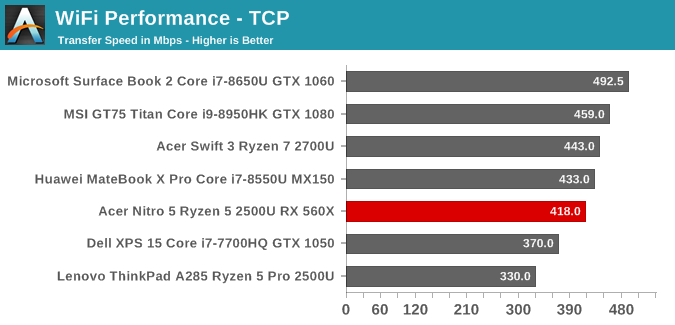
The performance of the Qualcomm adapter is decent. It doesn’t offer the much faster connections that are typical of the latest Intel wireless adapters, but it gets the job done. Reliability also seemed to be quite good, and there were no disconnects or other abnormal behaviour detected.
Audio
With just two stereo speakers and no subwoofer that you sometimes see on this size of system, expectations weren’t high, but despite only hitting about 75 dB(A) on our test track, the Acer delivered solid, crisp sound, with more dynamic range than expected. For software, Acer offers their Dolby Audio Premium software which works when using the headset jack.
Thermals
Acer outfits the Nitro 5 with Acer’s CoolBoost, which features two fans which draw air from the bottom and expel it out the back of the system. There’s also a software toggle to kick up the speed for maximum cooling if necessary, although in our testing it certainly was not necessary.
To test the thermals we ran Shadow of the Tomb Raider for just over an hour, measuring the GPU and CPU temperatures for the duration. The thermal performance of the Acer Nitro 5 was excellent, with no degradation in performance found, and quite low temperatures on the components. The GPU only went up to 71°C, with the CPU just under that at 68.9°C peak. Power draw on the GPU peaked at 72.5 Watts, and the GPU frequency was locked in at 1275 MHz with no deviation detected at all. Fan speeds were only at 35% as well, which kept the noise down to just about 46 dB(A) measured one inch over the trackpad.
Neither the AMD Ryzen 5 processor, nor the RX 560X, are too power hungry in a system of this size, but even so, the Nitro 5 does a great job of keeping everything cool without getting loud.
Software
As a value product, Acer has turned to offering some pre-installed software to help with margins, which is a practice we’ve seen less and less of by OEMs, which is ironic since Microsoft is now tapping that same well for Windows itself. The Acer Nitro 5 ships with Norton Antivirus, as well as an “Acer Collection” which opens to several Store apps. There’s nothing here too exciting.
The Acer Care software is something most manufactures offer now, with a single pane of glass to manage support, updates, and more, and unlike the other software that’s installed, is probably useful for almost anyone.
The laptop also comes with Acer NitroSense, which allows you to customize the fan profiles, set the power plan, and monitor the CPU, GPU, and fan speeds.
The software is simple to use, and works well. There's no macro support or anything that you might see on a higher priced gaming laptop, but for monitoring, it does the job well.


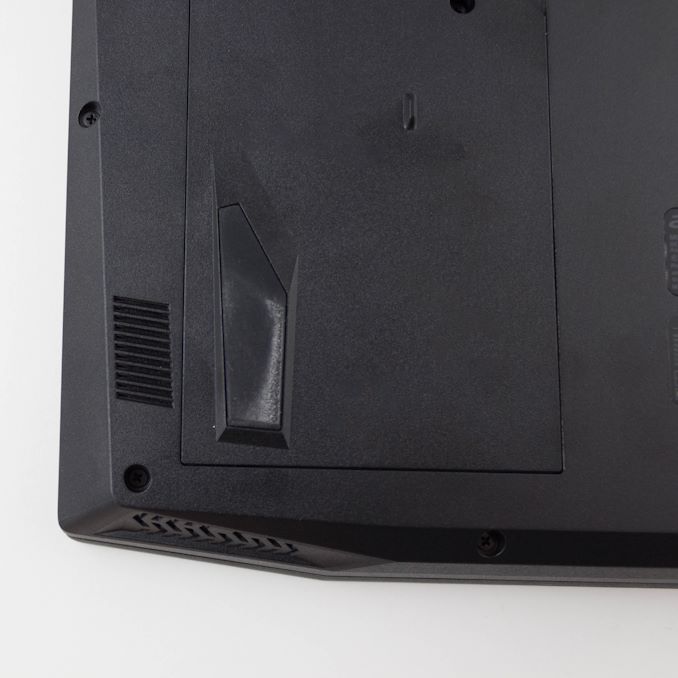
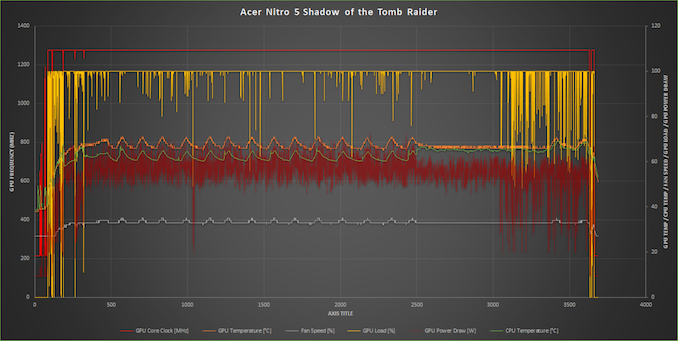
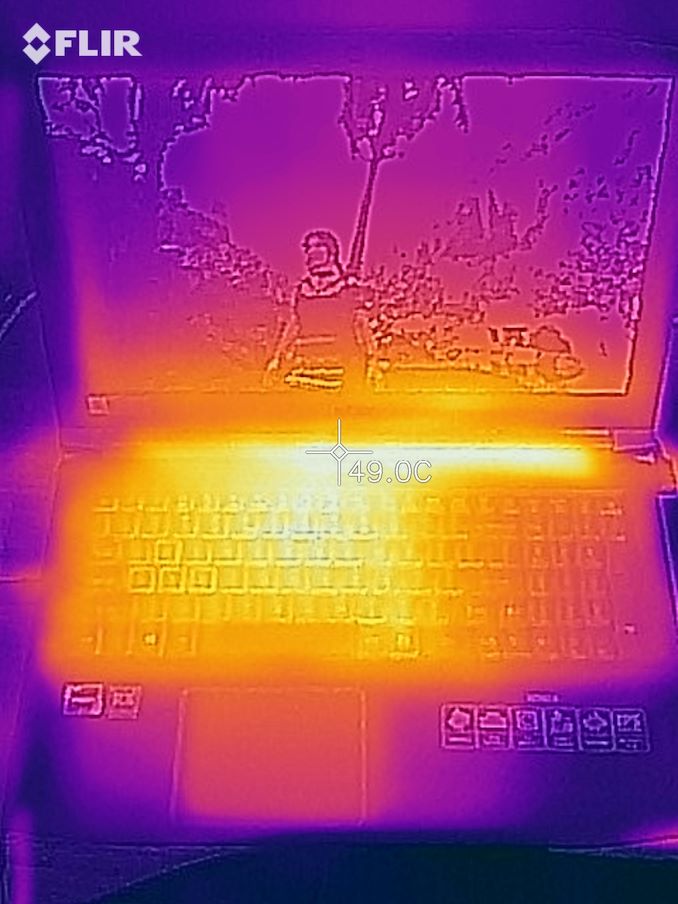
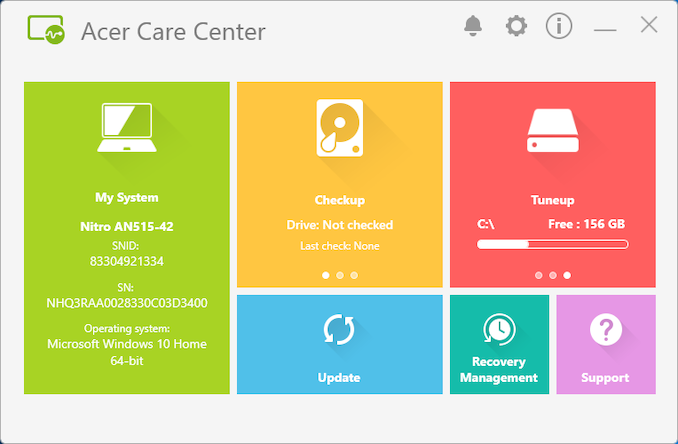
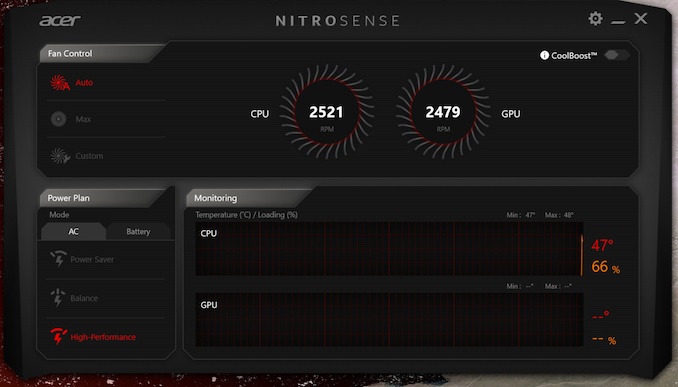








90 Comments
View All Comments
RSAUser - Friday, February 15, 2019 - link
Did you try and use the wattman auto undervolt for the graphics card?Does Radeon Chill work for mobile? Then fan noise should go down and battery should last longer.
Testing max fps is bad, don't even have minimum fps, let alone frame time plots to know how smooth it is.
jgraham11 - Friday, February 15, 2019 - link
Wow, did anyone notice that all the other processors are 45Watt meanwhile the AMD chip is only 15W!!! Holy crap!PeachNCream - Friday, February 15, 2019 - link
How can you miss that fact? The differences in TDP were pointed out multiple times in the article. You'd have to be in some serious skim mode to overlook it.cfenton - Saturday, February 16, 2019 - link
From the article: "Being a U series, the TDP is 15-Watts by default, though AMD offers a range of cTDP modes from 12-25 Watts. This is a rarely tapped feature on most laptops, but in this case it looks like Acer has put the Ryzen in cTDP up mode."So the AMD chip is 25w and the Intels are using 35w. It's a difference for sure, but it's not 15w vs 45w.
Brett Howse - Saturday, February 16, 2019 - link
The Intel ones are 45W - the 35W is an optional cTDP down mode.cfenton - Saturday, February 16, 2019 - link
My mistake. Thanks for the clarification.jgraham11 - Saturday, February 16, 2019 - link
For sure I believe you are correct, except for the MSI one which is 45watt.One thing I did find while looking at these specs for these Laptops:
Note all Newegg.com prices except the Acer AMD setup, as I could not find it. Prices are as of Feb 16 2019.
MSI GT75 TITAN GTX 1080 8 GB VRAM i9-8950HK sells for $4958.64
Huawei MateBook X Pro Intel Core i7 8th Gen 8550U MX150 sells for $1449.00
Dell XPS 15 core I7-7700HQ GTX 1050 sells for $1849.55
Microsoft Surface Book 2 Core i7 8650U GTX 1050 sells for $2279.00
This is not an Apples to Apples comparison in the least!
Meanwhile they are comparing it to a $699 AMD laptop....
Do you think that the extra $1k would provide a metal chassis which would result in better overall thermals hence better performance. And a better screen...
Anandtech please compare this one to another Acer Nitro 5 but with an Intel processor to actually make it a fair comparison.
Brett Howse - Saturday, February 16, 2019 - link
I explained why the comparison models were chosen in the review.fmcjw - Sunday, February 17, 2019 - link
Really? You don't take suggestions really well do you? I second jgraham11's suggestion because the thermal design makes each Intel Core a different beast.This is really an amateurish review, you can get as much info from a compact notebookcheck.com analysis. Who needs to be told that "Being a SATA based SSD, peak performance is certainly limited compared to NVMe drives, but it still offers orders of magnitude better performance compared to spinning drives?" Just show it in a table or chart. Are you being paid to hit a certain word count?
And you're unclear on whether adding a second RAM makes it dual channel, nor have you mentioned that you tried to see if Dual Channel is supported, but rather stuck to whatever configuration the company sent you.
Calin - Monday, February 18, 2019 - link
For spinning versus solid state hard drive performance, you have plenty of comparisons - when the transition took place, 5 or so years ago. Today's SATA SSD's aren't so much faster than the champions of 5 years ago (in typical end-user scenarios), but neither have the magnetic hard drive performance improved.